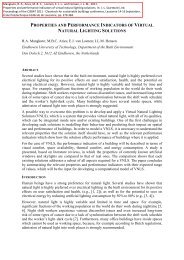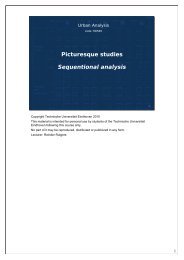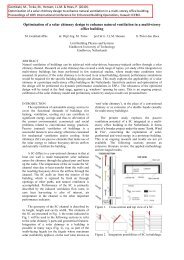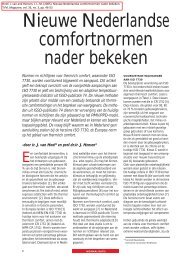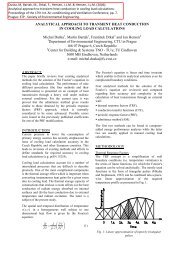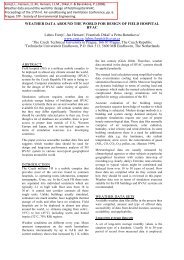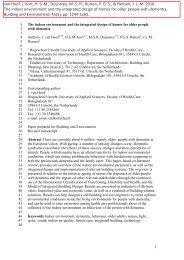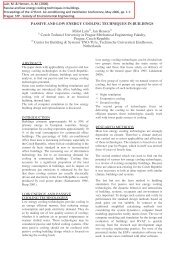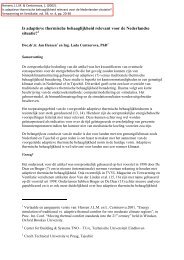literature review on thermal comfort in transient conditions
literature review on thermal comfort in transient conditions
literature review on thermal comfort in transient conditions
You also want an ePaper? Increase the reach of your titles
YUMPU automatically turns print PDFs into web optimized ePapers that Google loves.
Literature <str<strong>on</strong>g>review</str<strong>on</strong>g> <strong>on</strong> <strong>thermal</strong> <strong>comfort</strong> <strong>in</strong> <strong>transient</strong> c<strong>on</strong>diti<strong>on</strong>s -4-c<strong>on</strong>diti<strong>on</strong> of <strong>thermal</strong> <strong>comfort</strong> is therefore sometimes def<strong>in</strong>ed as a state <strong>in</strong> which there are nodriv<strong>in</strong>g impulses to correct the envir<strong>on</strong>ment by behaviour (after Benz<strong>in</strong>ger 1979). This is a moreobjective def<strong>in</strong>iti<strong>on</strong> than the ISO def<strong>in</strong>iti<strong>on</strong>.Accord<strong>in</strong>g to McIntyre (1980), it is c<strong>on</strong>venti<strong>on</strong>al to treat overall <strong>thermal</strong> dis<strong>comfort</strong> (a subjectivec<strong>on</strong>diti<strong>on</strong>) <strong>in</strong> terms of <strong>thermal</strong> sensati<strong>on</strong> (an objective quantity). This may be justifiable <strong>in</strong> case ofsteady-state c<strong>on</strong>diti<strong>on</strong>s however probably not when <strong>transient</strong> c<strong>on</strong>diti<strong>on</strong>s have to be judged. Thedifference between <strong>thermal</strong> <strong>comfort</strong> and temperature sensati<strong>on</strong> dur<strong>in</strong>g chang<strong>in</strong>g envir<strong>on</strong>mentalc<strong>on</strong>diti<strong>on</strong>s was clearly dem<strong>on</strong>strated by experiments of Gagge et al. (1967). They exposedsubjects for <strong>on</strong>e hour to neutral <strong>thermal</strong> c<strong>on</strong>diti<strong>on</strong>s (29 °C), then a step change to a much colder(17.5 °C) or warmer (48 °C) envir<strong>on</strong>ment for a two hour exposure, which was followed by a stepchange back to neutral c<strong>on</strong>diti<strong>on</strong>s. On enter<strong>in</strong>g the cold c<strong>on</strong>diti<strong>on</strong>s there were immediate reportsof cold sensati<strong>on</strong>s and dis<strong>comfort</strong>. On return<strong>in</strong>g to the neutral envir<strong>on</strong>ment dis<strong>comfort</strong> almostimmediately disappeared, while temperature sensati<strong>on</strong>s lagged c<strong>on</strong>siderably beh<strong>in</strong>d the <strong>comfort</strong>reports and did not return to neutral for all subjects dur<strong>in</strong>g the <strong>on</strong>e hour postexposure period. The<strong>transient</strong> exposures to the hot envir<strong>on</strong>ment showed much the same resp<strong>on</strong>ses. On enter<strong>in</strong>g the hotc<strong>on</strong>diti<strong>on</strong>s there were immediate reports <strong>on</strong> warm sensati<strong>on</strong>s and dis<strong>comfort</strong>. On reenter<strong>in</strong>g theneutral c<strong>on</strong>diti<strong>on</strong>s dis<strong>comfort</strong> disappeared rapidly however more slowly than <strong>in</strong> the case of thecold to neutral step. The temperature sensati<strong>on</strong>s showed an overshoot with some <strong>in</strong>itial reports ofslightly cool.In the past much work has been d<strong>on</strong>e aimed at f<strong>in</strong>d<strong>in</strong>g practical methods for predict<strong>in</strong>g the effectsof a particular <strong>thermal</strong> envir<strong>on</strong>ment <strong>in</strong> terms of <strong>comfort</strong> or dis<strong>comfort</strong>. Reviews and summaries ofthis were made by Hardy (1970), Fanger (1972), Benz<strong>in</strong>ger (1979), McIntyre (1980) andASHRAE (1985). From these references it is clear that there is much evidence (from steadystateexperiments) for cold dis<strong>comfort</strong> be<strong>in</strong>g str<strong>on</strong>gly related to mean sk<strong>in</strong> temperature and thatwarmth dis<strong>comfort</strong> is str<strong>on</strong>gly related to sk<strong>in</strong> wettedness caused by sweat secreti<strong>on</strong>. Theserelati<strong>on</strong>s are the basis for methods like Fanger’s (1972) Comfort Equati<strong>on</strong> and the work of Gaggeet al. (1973, 1986). In a recent evaluati<strong>on</strong> by Doherty and Arens (1988) it was shown that thesemodels are accurate for humans <strong>in</strong>volved <strong>in</strong> near-sedentary activity and steady-state c<strong>on</strong>diti<strong>on</strong>s.From the fact that the sk<strong>in</strong> thermoreceptors not <strong>on</strong>ly sense temperature but also the rate oftemperature change and that <strong>thermal</strong> <strong>comfort</strong> depends <strong>on</strong> an <strong>in</strong>tegrated value of central andperipheral temperatures, it may be c<strong>on</strong>cluded that sk<strong>in</strong> temperature al<strong>on</strong>e is unlikely to be anadequate <strong>in</strong>dex for cold dis<strong>comfort</strong> <strong>in</strong> <strong>transient</strong> c<strong>on</strong>diti<strong>on</strong>s. Because sweat secreti<strong>on</strong> reflects thegeneral state of the thermoregulatory system, sk<strong>in</strong> wettedness is probably a more adequatepredictive <strong>in</strong>dex for warmth dis<strong>comfort</strong> <strong>in</strong> <strong>transient</strong> c<strong>on</strong>diti<strong>on</strong>s than mean sk<strong>in</strong> temperature is forcold dis<strong>comfort</strong>. No experimental proof of this has been found however. From these observati<strong>on</strong>s<strong>on</strong>e may c<strong>on</strong>clude that the above menti<strong>on</strong>ed essentially steady-state methods are probably notadequate for predicti<strong>on</strong>s regard<strong>in</strong>g <strong>thermal</strong> <strong>comfort</strong> <strong>in</strong> <strong>transient</strong> c<strong>on</strong>diti<strong>on</strong>s.A number of models for simulati<strong>on</strong> of the dynamic behaviour of man’s thermoregulatory systemhave been developed <strong>in</strong> the past. A well known example is the model of Stolwijk (1970) whichwas later expanded by Gord<strong>on</strong> (1974). In this model the human body is divided <strong>in</strong>to a largenumber of segments (orig<strong>in</strong>ally 24 and <strong>in</strong> Gord<strong>on</strong>’s versi<strong>on</strong> 140) l<strong>in</strong>ked together via theappropriate blood flows. Each segment represents volume, density, heat capacitance, heatc<strong>on</strong>ductance, metabolism and blood flow of a certa<strong>in</strong> part of the body. The temperature and rateof change of temperature of each segment is available as an <strong>in</strong>put <strong>in</strong>to the c<strong>on</strong>troll<strong>in</strong>g system, andany effector output from the c<strong>on</strong>troll<strong>in</strong>g system can be applied to any part of the c<strong>on</strong>trolledsystem.The ma<strong>in</strong> applicati<strong>on</strong> field for this k<strong>in</strong>d of model is research <strong>on</strong> body temperature regulati<strong>on</strong>itself. No model has been developed which also predicts whether a particular <strong>thermal</strong>envir<strong>on</strong>ment is <strong>thermal</strong>ly un<strong>comfort</strong>able and to what degree. It may be possible to l<strong>in</strong>k a model



